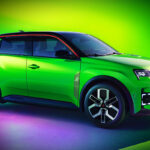 Something old, something new, something borrowed and, if you wish, something (Premium Ray) Blue. That’s what’s on offer with the new Suzuki Baleno – the name, the design, the engine and the colour.
Something old, something new, something borrowed and, if you wish, something (Premium Ray) Blue. That’s what’s on offer with the new Suzuki Baleno – the name, the design, the engine and the colour.
Sounding more like an exotic dance, the Baleno took its first steps in the 1990s as a ‘light’ passenger car. Now it has jumped the fence into the ‘small’ passenger segment, having the exterior dimensions of the former with interior space of the latter.
The new Baleno comes in two specification levels – GL with a 1.4-litre engine, with either a five-speed manual or four-speed automatic transmission, and the GLX Boosterjet 1.0-litre turbocharged variant, with six-speed automatic transmission.
Bigger than its sibling, the top-selling Swift, it shares engines and transmissions in some models.
The turbocharged Baleno (the test car), which features a new three-cylinder direct-injection Boosterjet system, has claimed fuel consumption of 5.2 litres per 100 kilometres on the combined urban / highway cycle. More about this in our Driving section.
The new Baleno comes to market from $16,990, drive away, for the 1.4-litre GL five-speed manual, with the four-speed auto adding $1000 to the price. The top-spec 1.0-litre Boosterjet turbo six-speed auto joins in at $22,990.
STYLING
The Baleno has taken the road of the majority of modern small hatchbacks with a a reasonably sleek look, without compromising interior space and all-round vision.
Suzuki Baleno GLX does what a top-spec vehicle should do – add little touches pleasing to the eye, if not to the pocket. Up front there are high intensity discharge headlamps, incorporating daytime running lights, while the look is lifted with 16-inch twin-spoke alloy wheels.

INTERIOR
Cabin width has been improved by reducing door liner intrusion into the front seats. Pushing the seats further apart gives more shoulder room for the driver and front passenger.
There is excellent knee and legroom between the front and rear seats and the Baleno can carry four adults with ease.
Even with the rear seat backs up, the cargo area can carry 355 litres of gear. In an interesting design move removable side trims in the boot deliver more space, allowing items such as a set of golf clubs to be carried sideways.
INFOTAINMENT
A central display screen, situated high on the central dashboard, is ideally placed at driver’s eye level with links to ApplePlay and MirrorLink smart phone interfaces which include music, maps, messages, current track information, audio books and podcasts, as well as navigation and rear camera viewing.
The 7.0-inch colour touchscreen home page is a simple quadrant which acts as the key to entry to audio, phone, sat nav and smartphone connectivity. The screen is flanked by air-con outlets, while controls and temperature gauge are positioned beneath within easy reach of the driver and front seat passenger.
Personalisation of graphics monitoring systems include engine power and torque outputs; real-time driving and tracked G-forces; accelerator and brake efficiencies; and average speed and fuel consumption.
ENGINES / TRANSMISSIONS
The 1.0-litre Boosterjet three-cylinder motor, with its six-speed automatic transmission, has it all over its 1.4-litre non-turbo brother in performance and fuel efficiency. But there is a price to pay: $6000 to be precise.
SAFETY
Six airbags are standard across the Baleno range, front and rear seats are equipped with pre-tensioners, side doors are fitted with anti-intrusion beams. Active systems include electronic stability control, anti-locking brakes with an electronic brake-force distribution system.
Also adding to safety is a new, lighter stronger platform that makes use of some extra-high-tensile materials while maintaining structural rigidity and thus occupant safety.
DRIVING
On taking position, the driver is introduced to the Baleno via an information display at the heart of the instrument cluster giving a clear picture of the state of the vehicle.
A 4.2-inch colour LCD screen displays a range of information including fuel efficiency, engine output, average vehicle speed and driving style.
In addition to traditional display information such as speed and engine revs, trip meters, distance to empty, average speed and warnings, drivers can tailor the dashboard display to any one of six set-ups.
At combined fuel cycle consumption of 5.2 litres per 100 kilometres for the 1.0-litre turbo is close to reality, something that’s not all that common these days. In the real world, the Boosterjet test car clocked 5.7 litres per 100 kilometres in city traffic and 3.6 litres per 100 kilometres at motorway speeds.
A lighter but extra-strong platform using high tensile material puts the Baleno ride and handling up with the best in the segment, while disc brakes all round on the GLX rein in the Boosterjet power when required.
SUMMING UP
The reinvented Suzuki Baleno is a world away from its 1990’s counterpart with an attractive design and spacious interior, while Boosterjet power delivers pleasing performance with welcome fuel economy. It’s an appealing package.
AT A GLANCE
MODEL RANGE
Suzuki Baleno 1.4 GL 5sp manual: $16,990 drive away
Suzuki Baleno 1.4 GL 4sp automatic: $17,990 drive away
Suzuki Baleno 1 GLX Booster Jet turbo 6sp automatic: $22,990 drive away
FEATURES
16in alloy wheels
HID headlamps with daytime running lights
Advanced information display
Multimedia satellite navigation
Apple Carplay
Remote keyless entry
Rear spoiler
Privacy glass
Leather covered steering wheel
Cruise control
Automatic air-conditioner
SPECIFICATIONS (Suzuki Baleno GLX 1.0-litre Boosterjet turbo petrol hatchback)
ENGINE:
Capacity: 0.998 litres
Configuration: Three cylinders in-line
Maximum Power: 82 kW @ 5500 rpm
Maximum Torque: 160 Nm @ 1500-4000 rpm
Fuel Type: Petrol 91 RON
Combined Fuel Cycle (ADR 81/02): 5.2 L/100km
DRIVELINE: Six-speed automatic
DIMENSIONS, WEIGHT AND CAPACITIES:
Length: 3995 mm
Wheelbase: 2520 mm
Width: 1745 mm
Height: 1470 mm
Turning Circle: 9.8 metres
Kerb Mass: 975 kg
Fuel Tank Capacity: 37 litres
BRAKES:
Front: Ventilated disc
Rear: Solid disc
STANDARD WARRANTY:
Three years / unlimited kilometres











